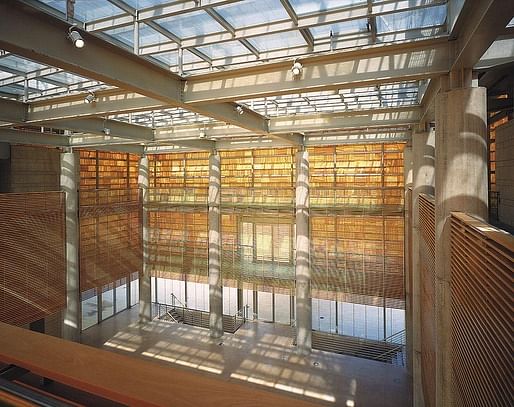
News
Architectural Digest interviewed Brad Pitt about his recently announced collection designed in collaboration with furnituremaker Frank Pollaro. mdler believed "you can tell the influence of Gehry in a few of his pieces” but Orhan Ayyüce commented "These belong to ‘Italian’ furniture store in your neighborhood...I agree with Xenakis that he should bite the bullet and go to design school for few years. He could even have home schooling but better he learns like the rest of the design students".
ObjectThinking wanted to get honest "The title of this post is disingenuous. If you read the linked article from Architectural Digest Pitt states that his input was fairly minimal...Frank Pollaro clearly deserves most of the ‘credit’ for what was produced...The pity is that companies who should be engaging really talented designers choose to snag untrained celebrities and get them to ‘art direct’ or ‘curate’ things in the knowledge that the big names will shift units”.

The Seattle Times reported that The David & Gladys Wright house in Phoenix is going to be saved. Sold for the listing price of nearly $2.4 million to a buyer who wishes to remain anonymous. Kevin W. shared "There are rumors that Moby purchased it.” while Paul Petrunia quipped "If it's Pitt I'll totally forgive him for that furniture he designed.”
Twitter user @jculpjr, also pointed out a video walkthrough of the property. John E. Williams referring to what appeared to be a ground floor bathroom "with the house lifted above the ground as it is, it's probably handy to have one at ground level. It also looks like there might be a pool there on the other side of it”.

YOUR TEXT HERE is a participatory, site-specific light installation by Marcus Zotes. The project aims to empower local communities by providing a tool that transforms people voices into citizen proclamations the size of buildings using anonymous text messaging. The project was performed as part of DLECTRICTY, an outdoors light art festival in midtown Detroit that took place during October 5th and 6th, 2012. Donna Sink loved "this so, so much”.

Last week, in light of the recent devastation caused by Hurricane Sandy, Alan Feuer examined three examples of how to protect New York City from future storms. HandsumCa$hMoneyYo contended "I don't see how building sea gates could possibly be worth the cost...Makes far more sense to leave the most vulnerable areas to the poor people, yo!"
Firms/Blogs/Work Updates
Ibrahim Rajah recently worked on Air~chitecture and Amy Leedham provided a review of the "top designs" from the European Solar Decathlon which took place in Madrid in late September and included teams from around Europe as well as Brasil and China. They included Team Rhone-Alpes’s modular Conopea House, Team Andalucia’s Patio 2.12 House and Germany’s ECOLAR House.

AwesomeArchitecture showed off Y House by SousaSantos which FRaC felt "is awesome! except those roll-down shades on the big curved window (last image) should be recessed into a slot in the ceiling".

For those looking for the architecture of "A new social order" you might want to check out Socialopolis by ARTMEADOW a design studio located in New York City, founded in 2009 by Matthew Hoffman.

School Blogs
Susan Surface at Yale University, penned Sandy / sadNY. Therein she wrote "Hopefully, the grassroots organizing around Sandy is not limited to disaster relief, but will initiate a radical rebuilding of the East Coast. We can build up the interpersonal infrastructures of reliability, availability, skill-sharing, resources, sweat and organization that will carry us far beyond this crisis".
Matthew Messner at UIC, posted two essays exploring what the design of particular aspects of the just completed United States presidential election campaign, tell us about our electoral process and our democracy, as part of Sam Jacob's Designing Criticism class. The first essay, by Adrianne Jørgensen is about the furniture of the debates. The second essay was his own.
In his first school-blog post Kyrylo Verbych, sudying at The Odessa Institute of Fine Arts and Architecture, highlighted the findings from the International "Project Management in City Parks’ Landscaping and Development Sphere in Financial Crisis Conditions" seminar that took place in October. The working groups’ recommendations were later presented to municipal authorities.
David de Céspedes laid out The Premiss of Middle-Urbanism. Nathan_B noted "I have heard the phrase ‘Middle Urbanism’ used, but not to define a place type, but rather as an alternative architectural/urban design theory which sits between two opposing urban intervention strategies (Empiricism vs. Imposition). It comes from Michael Piper, partner of DUB Studios in New York (as far as I know. There may be other precedents). He is teaching a course at the Daniel's Faculty of Architecture, Landscape and Design at the University of Toronto this semester called Forming Middled Urbanisms."
David responded "Michael Piper's work looks promising. I plan to unfold the Middle-Urbanism theory more concisely through specific reflections on historical precedent and projective imaginaries of the Quad Cities context. It does seem to me thus far that very little emphasis has been placed on the non-metropolis cities that have neither been absorbed by mega-cities, nor fit into the suburb classification".
Discussions
NoNameNum3 wanted to discuss Diversity in Renderings, explaining "So I spent the last little while looking at purchasing scale figures for renderings and I can only seem to find white people. The packages come with 1 or 2 people of different ethnicities...but that doesn't quite cut it for the location of the project I'm working on (DC). Anyone have any tips on where I can find a diverse set of people for purchase?". Randh didn’t have any suggestion but wished NoNameNum3 "Good luck, and when you decide to cut out your own, good luck finding enough that you can legally use and that are not reinforcing negative stereotypes".
Donna Sink is looking for super good thermally-broken storefront windows to replace existing 20-year-old aluminum storefront in a limestone surround. Russell Higgins
clarified "You need a system that states it is actually thermally broken, not thermally improved. Most reps won't know the difference and will try to tell you that thermally improved is the same--it is not. One of the problems with storefront systems is that there will most likely be sub-sill flashing which extends from the exterior to the interior; 'short circuiting' any thermal break that the sill section has". To which Rusty Shackleford added "Kawneer, EFCO, TRACO, Tubelite, Vistawall, Trulite. Be weary of of manufacturers outside that list".
Meanwhile taz chimed in "A program called THERM (free from LBNL) is pretty much the industry standard to review thermal performance of glazing details and assess condensation risk (based on the dew point temperature)” annnnd mantaray noted "I love these kinds of threads. Thanks for posting Donna, and thanks for contributing knowledge, everyone"!

Finally, c is working on a proj. with horizontal limestone stone component in a curtain wall system. anchoring off slab - and not embedded or tied to precast element... and needs help rustling up some "curtain wall precedents which incorporate cut stone".
Apurimac responded "Below is an image of a stone curtain wall system that is not only translucent, but blast resistant used in the Israeli Foreign Ministry. There are many ways to put stone in a spandrel, or clip it off a facade. A noteworthy project that uses limestone curtain wall is 15 Central Park West by Bob Stern & Co. Although its a good example of of how panels really should be book matched to each other as the buildings facade looks disjointed. Also noteworthy is the shunt lines in the facade are really, really obvious when the light hits the building in the right way, as many of the panels aren't quite flush with each other" and curtkram added "i saw a product a little while back that was a really thin veneer from natural stone. so thin it could bend, and was somewhat translucent. you could put it in a shoji screen type thing and back-light it. i thought it was pretty cool".
Additionally
The The International Symposium on Urbanism, Spirituality & Well Being will take place June 6 – 9, 2013 at Glastonbury Abbey, Hingham, Massachusetts & Harvard University Divinity School, in Cambridge, Massachusetts. The deadline for presentation/paper proposals is January 14, 2013. Papers are invited for the following topics: Urbanism of the Past, Present Urbanism, Future Urbanism and Open Sessions.
5 Comments
Oh dear that shirt is ugly. Brad, just go ahead and take it off.
And where are they at? Is that supposed to be a design studio or a wine bar?
Yo!
@handsum according to the Architectural Digest it is in the wine cellar of Brad's house in (southern I think) France.
Come on Donna, he just rode in on his KX500.
Funny, Donna, but weren't you just lamenting the objectification of women in another thread?
Block this user
Are you sure you want to block this user and hide all related comments throughout the site?
Archinect
This is your first comment on Archinect. Your comment will be visible once approved.